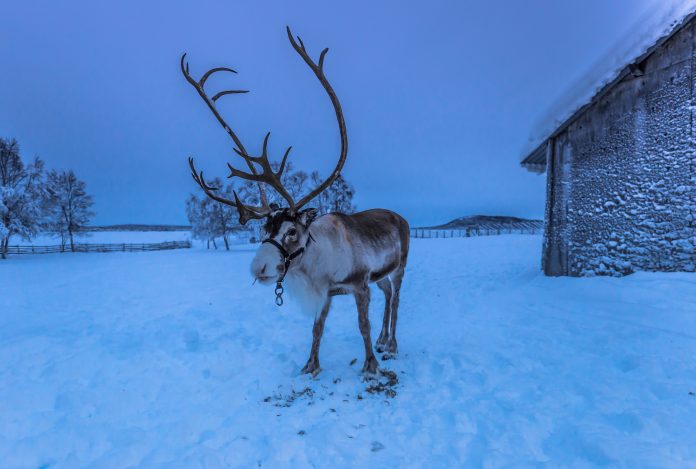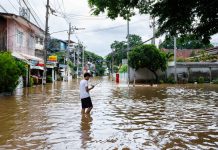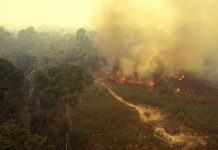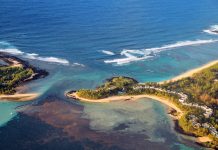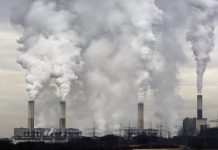Dr Aidan Bell, co-founder of EnviroBuild, discusses the impact climate change has on Indigenous people around the world
Reindeer herding isn’t for everyone, but for the Sami, it is a way of a life. For approximately nine thousand years, Sami herders have made the trek from their summer pastures to the wintering grounds in the north of Sweden, Norway, Finland and some parts of Russia. The knowledge that was passed on from generation to generation made the tundra easy to navigate for a migration which was necessary for the survival of their herds.
The snow cover that could be found at the end of their journey meant lichen, a fungi-algae organism that reindeer feed on, was relatively easy to find.
With temperatures rising globally, ice caps melting and extreme weather becoming the norm, the snowfall which was found at the end of the Sami’s trip has been replaced by rain and mild winters preventing reindeer to access the much-needed lichen.
We are all aware of global warming and its effects have been taken more seriously over the past years, but most of the time this is only in an economic context. When discussing climate change it is concerning water, our infrastructure, perhaps even agriculture, but rarely will Indigenous people be acknowledged. This is surprising as there are approximately 370 million Indigenous people belonging to 5,000 different groups across 90 countries, making up about 5% of the world’s population.
Their intimate relationship with the environment and its resources, and their lack of finance and technological developments also makes them the first to face direct consequences of climate change. It does make you wonder why the threat to their lives, mostly created by us, isn’t discussed more frequently.
Extreme weather: A danger to Indigenous people
The potential consequences associated with global climate change are generally well understood and one of these repercussions is the increase of extreme weather. We have all heard the scientific reports that state that heatwaves, droughts, floods and storms will become more frequent and more extreme. Look at Hurricane Harvey in 2017, one of the costliest storms in the US, or the scorching hot temperatures across Europe just this summer. There’s plenty of examples to be given, but only a few of the ‘breaking news’ articles mention Indigenous people around the world.
Living in rural parts of India are some 170 million people who are physically, socially and economically excluded from the rest of the world known as the Dalits. They are sometimes referred to as ‘The Untouchables’, not only because of how isolated they are but also because they are believed to be the lowest castes of Hindu society. The Dalits have adapted their farming systems to the fifteen agroclimatic zones and diverse crop seasons India has to offer, but these zones and seasons have also made their lifestyle very prone to climate change.
The increase of intense floods in the area has had dire consequences on the farming culture of the Dalits; the knowledge that they have relied on for generations has now led them to doubt their ancestors.
The Dalits position in society, or rather lack thereof, has also made survival during monsoon season more difficult than for others in the area. When India was hit by unusually severe monsoon floods in 2007, relief workers helped thousands of people, but rarely took care of the Dalits. In the aftermath of the floods, a survey found that 60% of the deceased were Dalits and that none of the Dalit colonies had been visited by government relief officials. Aid workers either did not realise that Dalits lived outside the main villages, or dominant groups took control of distribution.
This was not the first time, and won’t be the last, that Indigenous communities were ‘invisible’ to aid. In 1998, severe floods in Slovakia meant that nearly 4,000 people had to be evacuated. Roma communities in Jarovnice, the village that was affected the most, were however worse off than white people.
Not only did 140 of the affected homes belong to Roma compared to 25 non-Roma homes, 45 out of the 47 people who were killed were also Roma; a clear disproportion which could have been prevented if more aid was provided.
The threat of habitat reduction happens in more than one way
When you think of habitat reduction, the main thing that comes to mind is the much-discussed rainforest known as the Amazon. The loss of trees as a result of deforestation for various reasons has not only led to an increase of carbon dioxide, but the reduced water released by plants into the atmosphere has also influenced the world climate and the circulation of ocean currents. On top of this, current models suggest that between 30 and 60% of the rainforest could become a dry Savannah, which has major impacts for not only the Amazon’s wildlife but also the 400 tribes, adding up to about one million Amerindians, their ancestral homes.
Biofuels have, perhaps unexpectedly, contributed to the risk of habitat loss alongside deforestation. The lower emissions of carbon dioxide that biofuels produce compared to fossil fuels have made it an appealing renewable source of energy for many Western governments to back. Plantations have started to pop-up all over the world with some of the major ones in Indonesia, Malaysia and Columbia. These do not, however, always come into existence in the most ethical way. Since there was a notable increase of biofuel plantations, deforestation has increased and many Indigenous people have migrated to bigger cities as they were forced of their lands to make place for plantations.
In Columbia, for example, rapid growth of the palm oil industry has not happened without any violence. Having doubled its palm oil output in the past decade, the country is now the largest producer of the product in Latin America. To claim the land for plantations, companies have employed armed guards and paramilitaries to use intimidation, violence and even murder to get smaller landowners, farmers and Indigenous people off the land they wish to use for their plantations.
At the moment, 12 out of the 84 officially recognised Indigenous groups in the area are on the brink of extinction partly as a result of land grabbing. Torn by a vision of rural development or an agribusiness that promises growth, jobs and modernization, the government has only recently started to sort through the claims of people who say they have been driven off their land.
There is, however, a light at the end of the tunnel as Extinction Rebellion International posted on Instagram that “the past 30 years have seen remarkable progress in the recognition of Indigenous peoples’ rights, with important milestones being the adoption of the UN Declaration on the Rights of Indigenous Peoples by the UN General Assembly in 2007”.
They did continue to push for change as “in many places, laws are not fully implemented which can leave communities struggling for survival”.
In this day and age, Indigenous people still only have a legal right to 10% of the world’s land while sustainably managing 50% of it, showing that laws are indeed not put into effect in some countries around the world.
Short-term creativity, long term collaboration
Indigenous people remain, however, adaptable and creative at heart and they are quick to find solutions to keep their culture, but mostly themselves alive. Sami herders are now transporting food to their reindeer in winter when they cannot find the lichen, and for Dalits, floating gardens were the answer to increasingly severe Monsoons that have affected them over the past years.
Even so, climate change does directly threaten the livelihoods of Indigenous communities, putting agricultural practices that they have followed for decades in danger.
The consequences of global warming will most likely not stop anytime soon. Transporting food requires finances that the Sami do not have and the floating gardens may not stand the test of time.
In the Arctic, the unpredictable weather has made interpreting the environment increasingly more difficult and Indigenous people have started to help drug-traffickers, let gold prospectors and loggers in their forests, and found many other, unethical and dangerous means of survival.
The creative, short-term solutions Indigenous people have come up with are simply not sustainable. It is up to us, the government and corporations to implement ethics and the environment into their mission statements and adhere to them in order to make real change happen.
The Norwegian government could, for example, make their Reindeer Husbandry Act more flexible so that it permits the Sami to come up with new practices they need to adapt to climate change. Palm oil organisations, who often influence Columbian and other governments, could also get rid of their inhumane resources to gain land and start growing palm in the right places with the right practices, simultaneously avoiding deforestation to make space for these plantations. It is also time to start treating Indigenous people as equals; give them the help and support they deserve whether this is through aid when extreme weather hits, or simply by starting to implement them in government and international organisations’ climate change plans.
We, at EnviroBuild, try and prevent deforestation, allowing Indigenous people to stay in the habitat that they have called home for thousands of years, by ensuring that the materials we sell, including our packaging, come from recycled sources that can be recycled again. By donating 10% of our profits to Rainforest Trust UK, we also aim to help them bring long-lasting, high impact benefits to the environment, eco-systems and its local communities. To read more about our pledge to the environment, click here.
References
https://www.un.org/development/desa/indigenouspeoples/climate-change.html
https://minorityrights.org/wp-content/uploads/old-site-downloads/download-524-The-Impact-of-Climate-Change-on-Minorities-and-Indigenous-Peoples.pdf
https://www.survivalinternational.org/galleries/reindeer
https://wtop.com/world/2018/11/10-of-the-deadliest-natural-disasters-in-2018/
https://www.indiatoday.in/india/story/your-monsoon-roundup-flood-leave-16-dead-in-maharashtra-situation-worsen-train-derailed-in-odisha-1578448-2019-08-08
https://www.epa.gov/climate-indicators/weather-climate
https://www.businessinsider.com/most-destructive-hurricanes-in-us-history-2017-8?r=US&IR=T#hurricane-sandy-2012-714-billion-14
http://www.indiaenvironmentportal.org.in/files/file/climate%20change%20Dalits.pdf
https://wwf.panda.org/knowledge_hub/where_we_work/amazon/amazon_threats/climate_change_amazon/
https://www.survivalinternational.org/about/amazontribes
https://www.theguardian.com/world/2015/jan/26/colombia-palm-oil-industry-conflict-farc
https://www.washingtonpost.com/world/the_americas/in-colombia-a-palm-oil-boom-has-its-roots-in-years-of-fighting/2014/12/29/ae6eb10c-796b-11e4-9721-80b3d95a28a9_story.html?noredirect=on
https://news.mongabay.com/2018/05/how-colombia-became-latin-americas-palm-oil-powerhouse/
https://www.culturalsurvival.org/issues

